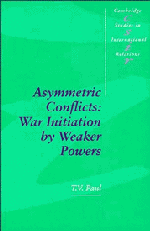Book contents
- Frontmatter
- Contents
- List of tables
- Preface
- PART I THE THEORETICAL FRAMEWORK
- PART II THE CASE STUDIES
- 3 The Japanese offensive against Russia, 1904
- 4 The Japanese attack on Pearl Harbor, 1941
- 5 The Chinese intervention in Korea, 1950
- 6 The Pakistani offensive in Kashmir, 1965
- 7 The Egyptian offensive in the Sinai, 1973
- 8 The Argentine invasion of the Falklands/Malvinas, 1982
- Conclusion
- Notes
- Bibliography
- Index
- Titles in the series
4 - The Japanese attack on Pearl Harbor, 1941
Published online by Cambridge University Press: 03 May 2011
- Frontmatter
- Contents
- List of tables
- Preface
- PART I THE THEORETICAL FRAMEWORK
- PART II THE CASE STUDIES
- 3 The Japanese offensive against Russia, 1904
- 4 The Japanese attack on Pearl Harbor, 1941
- 5 The Chinese intervention in Korea, 1950
- 6 The Pakistani offensive in Kashmir, 1965
- 7 The Egyptian offensive in the Sinai, 1973
- 8 The Argentine invasion of the Falklands/Malvinas, 1982
- Conclusion
- Notes
- Bibliography
- Index
- Titles in the series
Summary
The Japanese attack on Pearl Harbor has been described as an “act of suicide,” a “supreme folly,” and a “strategically idiotic move.” This description has been largely based on a commonly held assumption that a relatively small state that wages war against an opponent who possesses superior power capability is indeed making an irrational choice. This chapter attempts to unravel the decision-making process of Japan's power hierarchy to see why the leaders opted to strike in December 1941 even when they knew that they were waging war against a country that possessed eight times more economic and industrial capacity and had the potential military power to destroy the Japanese state itself. Going by the accounts of the Japanese decision-makers, it is clear that the leadership was aware of the potential as well as the existing strength of the adversaries whom they were confronting and the risks involved in a war with the US which meant fighting the Allied forces too.
The disparity in overall capability between the two antagonists in 1941 was spectacular. The population of the US was nearly twice that of Japan and it held a seven times higher national income. In steel and coal, the US produced five times and seven times respectively as much as Japan. The average annual industrial production of the US during this period was seven to ten times higher than that of Japan.
- Type
- Chapter
- Information
- Asymmetric ConflictsWar Initiation by Weaker Powers, pp. 64 - 85Publisher: Cambridge University PressPrint publication year: 1994



